Recent News
- Interdisciplinary research and the integration of perspectives May 31, 2022
Assistant professors Dr Sabyasachi Mukhopadhyay and Dr Imran Pancha from the Department of Physics and the Department of Biological Sciences, respectively, along with Ms Ashwini Nawade, a PhD student of the Department of Physics, have developed a method to integrate plant proteins in the solid-state electronic circuits and utilize the biological functionality to produce a thin film, cost-effective photodetector. Their paper entitled Electron Transport across Phycobiliproteins Films and its’ Optoelectronic Properties has been published in the ECS Journal of Solid State Science and Technology with an Impact Factor of 2.07. It is an interdisciplinary research project between the Department of Biotechnology and Physics.
Explanation of the research
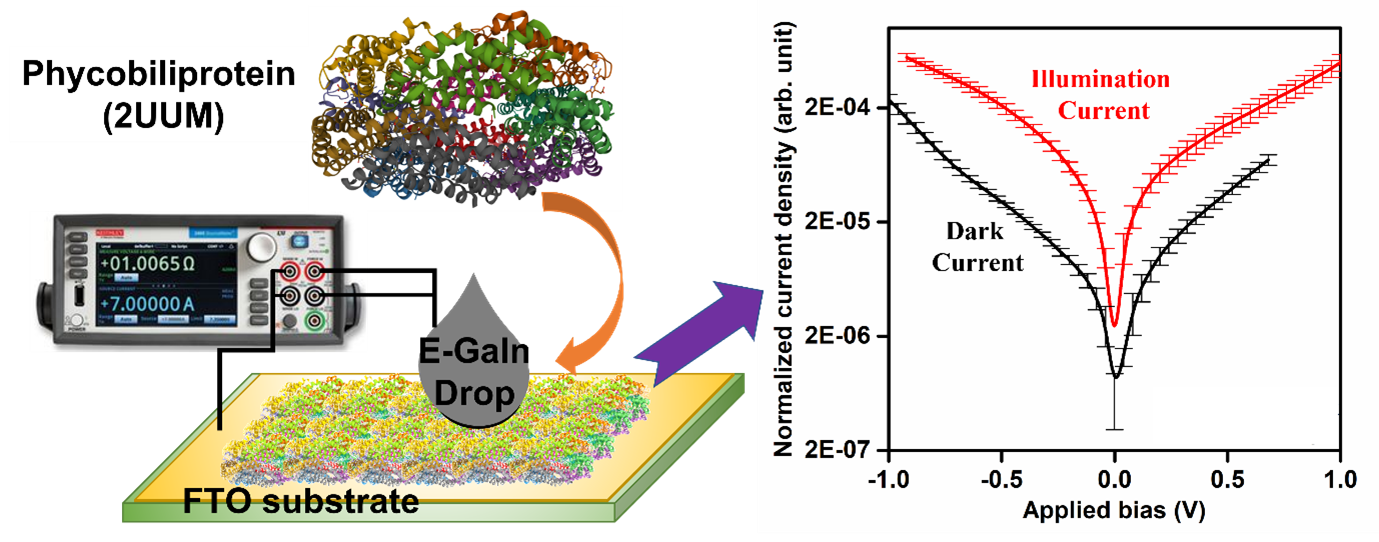 Biomolecules such as proteins, peptides being the most crucial life-forms, have an intimate relationship with various life activities for biological functions. The contemporary work with biomolecules mainly focuses on its evolving potential associated with nanoscale electronics where proteins and peptides are integrated as sensing materials. The researchers explored the optoelectronics functionality of combined proteins known as phycobiliproteins. They investigated electron transport behavior across the phycobiliproteins films under dark and white light illumination. The research affirms that the photochemical activity of the protein is more stable in a solid-state/ thin-film with tightly bonded water molecules than its presence in a buffer solution. Furthermore, the studies demonstrate that phycobiliproteins films modulate their electrical conductivity within their different conformation states. Researchers speculate that the electrical conductance variation could originate from the chemical alteration of cysteine-conjugated bilin chromophores to protein and the electrostatic environment around the chromophores.
Biomolecules such as proteins, peptides being the most crucial life-forms, have an intimate relationship with various life activities for biological functions. The contemporary work with biomolecules mainly focuses on its evolving potential associated with nanoscale electronics where proteins and peptides are integrated as sensing materials. The researchers explored the optoelectronics functionality of combined proteins known as phycobiliproteins. They investigated electron transport behavior across the phycobiliproteins films under dark and white light illumination. The research affirms that the photochemical activity of the protein is more stable in a solid-state/ thin-film with tightly bonded water molecules than its presence in a buffer solution. Furthermore, the studies demonstrate that phycobiliproteins films modulate their electrical conductivity within their different conformation states. Researchers speculate that the electrical conductance variation could originate from the chemical alteration of cysteine-conjugated bilin chromophores to protein and the electrostatic environment around the chromophores.The research explores the photochemical properties and electrical transport efficiency of phycobiliproteins (PBPs) films. In addition, it investigates the optoelectronics functionality of PBPs films by studying electron transport behavior across the protein films under a dark state and white light illumination. The researchers proposed to develop a photodetector with the protein film in the future.
Continue reading → - Co-edited and authored in the world’s longest-running science journal May 27, 2022
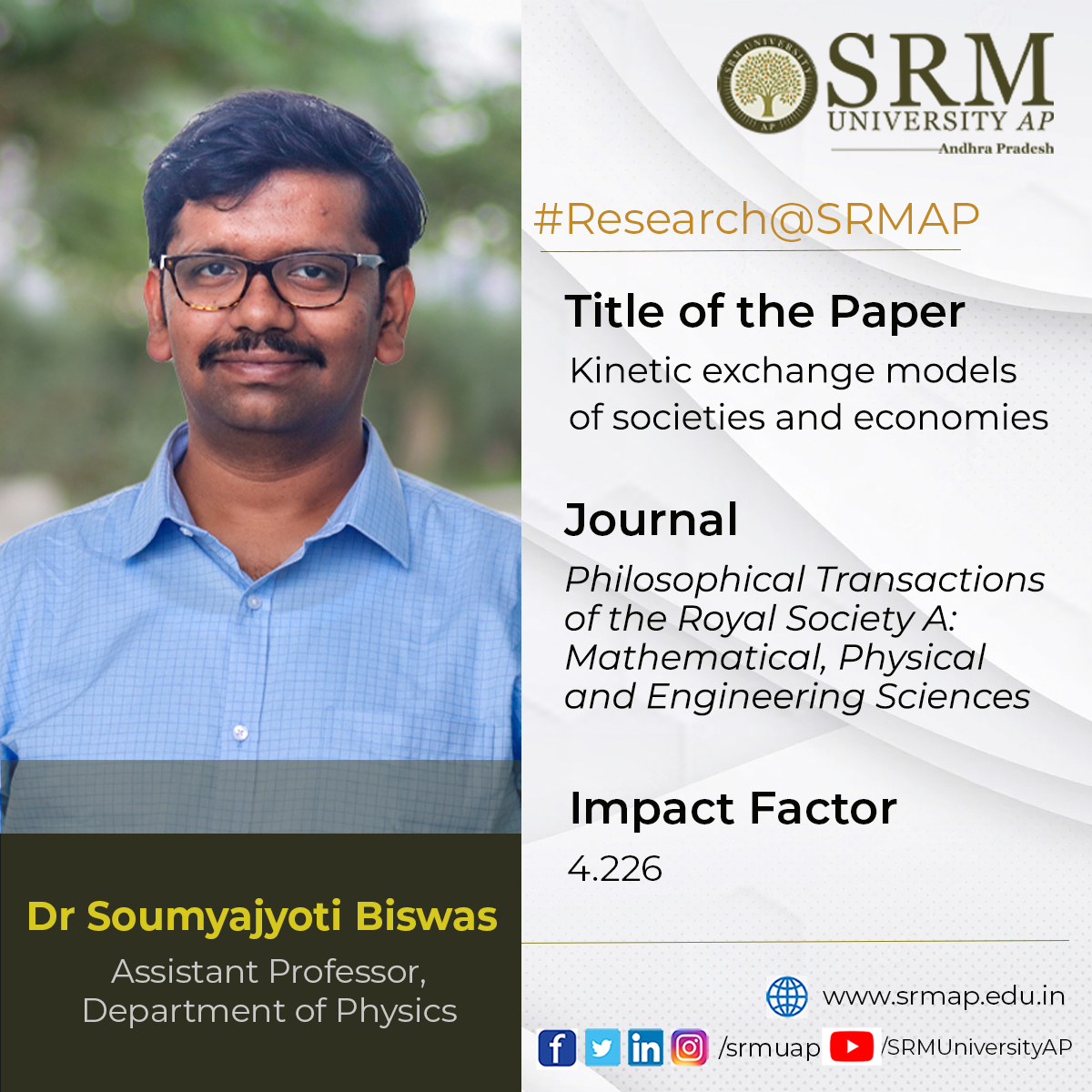
Dr Soumyajyoti Biswas, Assistant Professor, Department of Physics, had two lucky breaks as he got his article “Kinetic Exchange Models of Societies and Economies” featured in the prestigious journal Philosophical Transactions of the Royal Society A, the theme issue co-edited by Dr Biswas himself, along with Dr Guiseppe Toscani from the University of Pavia, and Dr Parongama Sen from the University of Calcutta. Philosophical Transactions of the Royal Society has the prestige of being the world’s longest-running science journal launched in 1665. Publishing high-quality theme issues on topics of current importance and general interest within the physical, mathematical, and engineering sciences, the journal continues its history of influential scientific publishing.
A kinetic model of binary interaction, with conserving or non-conserving exchange, has been an elegant and powerful tool to explain collective phenomena in myriad human interaction-based problems, where an energy consideration for dynamics is generally inaccessible. Nonetheless, in this age of Big Data, seeking empirical regularities emerging out of collective responses is a prominent and essential approach, much like the empirical thermodynamic principles preceding quantitative foundations of statistical mechanics.
Through this theme issue, the authors intend to bring together the current progress in the applications of kinetic exchange models in various applications of societies (opinion formations, rating, social networks, fake news, etc.) and economies (inequality measures, taxation, trade models, behavioral economics, etc.) using numerical simulations, machine learning techniques, analytical methods, and data analysis, reported by physicists, social scientists, mathematicians and economists through some of the original and reviewed articles.
In human interactions, such as a trade (exchange of money) or, discussions or debates (exchange of opinions), following simple dynamical rules, a collection of agents (a society) shows emergent properties that are widely seen in real data (distributions of wealth, formation of consensus, etc.). Without knowing the complexities that are involved at the individual levels, it is, therefore, possible to understand the average properties of the society as a whole. This is reminiscent of simple elastic collisions of ideal gas molecules that give average thermodynamic properties, such as temperature, pressure, etc. without knowing the complexities of the individual atoms. This has been a widely followed route to formulate statistical physical models of societies and economies.
The kinetic exchange models have been a very successful set of tools to understand the socio-economic emergent properties from simple models. Among other things, these models helped understand the growth of economic inequalities, the effects of taxes as well as the spread of opinions. A close quantitative resemblance with real data from various countries of the world demonstrates its usefulness.
The future prospects of the kinetic exchange models for societies and economies include possible predictions of extreme fluctuations in average measurable quantities by looking at the inequality of time series data. The models can help us in identifying the features of the real data that can mirror the underlying extreme fluctuations.
Continue reading → - PAN/PVP blend nanofiber air filtration mechanism May 18, 2022
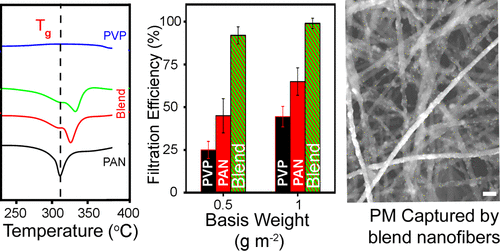
Studies and research on air pollution have sparked worldwide interest in the recent decades to overcome the imminent threat of air pollution. The air filtration mechanism is one of the efficient ways to capture particulate matter (PM) and purify the air. An innovatory air filtration mechanism blending polyacrylonitrile (PAN)/polyvinylpyrrolidone (PVP) polymer nanofibers has been proposed by Prof Ranjit Thapa and his PhD scholar Deepak S Gavali from the Department of Physics.
The paper “Low Basis Weight Polyacrylonitrile/Polyvinylpyrrolidone Blended Nanofiber Membranes for Efficient Particulate Matter Capture” was published in collaboration with Applied NanoPhysics Laboratory, Department of Physics and Nanotechnology, SRM Institute of Science and Technology, Kattankulathur. It was featured in the journal ‘ACS Applied Polymer Materials’ having an Impact Factor of 4.09.
In the twenty-first century, air pollution is a major problem facing human and environmental health. Every year, millions of people die, mostly in developing nations, owing to the aggravating level of air pollution. According to the World Health Organization (WHO), 92 per cent of the people live in places where the air quality level has crossed the WHO limits. Particulate matter (PM) (solid or liquid particles with different aerodynamic diameters), nitrogen dioxide (NO2), ozone (O3), and others are the relevant air contaminants.
In low-income cities, the effect of PM 2.5 pollution is high due to high urban air pollution. Even at very low concentrations, PM 2.5 (particles with an aerodynamic diameter less than 2.5 µm) pollution has health consequences. Air filtration is one of the best remedies to tackle such problems and maintain a clean environment for humans. Among the available air filter materials, fiber-based air filters have proven to be the most potentially effective treatment, due to their high porosity, high surface area, lightweight, etc.
This study relies on a careful design that blends PAN and PVP fibers. The resultant nanofiber material is utilized to overcome the low air pressure resistance issue with high filtration efficiency. Large-scale free-standing nanofibers were obtained by a simple peeling-off process. The morphology, chemical interaction between the filter media and PM pollutant; and filtration properties were investigated. Compared to commercial mask, the semi- high-efficiency particulate air (HEPA) filter media, PAN/PVP filter medium showed superior performance in PM 2.5 filtration. Furthermore, the intermolecular interactions between PMs and nanofibers were analyzed by DFT calculations. With constant optimization of synthesis conditions, the synthesized air filters achieved high filtration efficiency for PM removal and showed great potential for practical application.
Abstract of the Research
Particulate matter (PM) in air frequently poses a serious threat to human health. Smaller PM can easily enter into the alveolus and blood vessels with airflow. This work reports the first polyacrylonitrile (PAN)/polyvinylpyrrolidone (PVP) polymer blend nanofiber filter media for effectively capturing PM. Density functional theory (DFT) calculations are used to investigate the effect of the blending of two polymers on the dipole moment and the electrostatic potential. Based on the DFT calculations of the intermolecular interactions between nanofibers and PM, the PAN/PVP heteromolecular percentage is considered for experimental synthesis, which can provide better performance in the filtration of pollutants. The composite PAN/PVP fiber network was successfully developed and optimized to cope with complex environments during the actual filtration process. The role of the blending ratio of PAN and PVP in wt % was explored on PM 2.5 capture, and the refined ratio overcame the conflict between high filtration efficiency and low air pressure resistance. The air filter medium PAN/PVP (6:2) possesses an extremely high air filtration efficiency of 92% under a very low pressure drop of 18 Pa for a 0.5 g m–2 basis weight. Both polar and nonpolar functional groups in blend nanofibers promoted significantly the electrostatic attraction and improved the filtration efficiency under static and dynamic airflow. The PAN/PVP nanofiber membranes maintain outstanding air filtration under different temperature and humidity conditions. This study will shed light on the fabrication of high-efficiency low-basis weight nanofiber filter media as an end product.
Continue reading → - Faculty Development Programme on Implementation of Sponsored Projects May 14, 2022
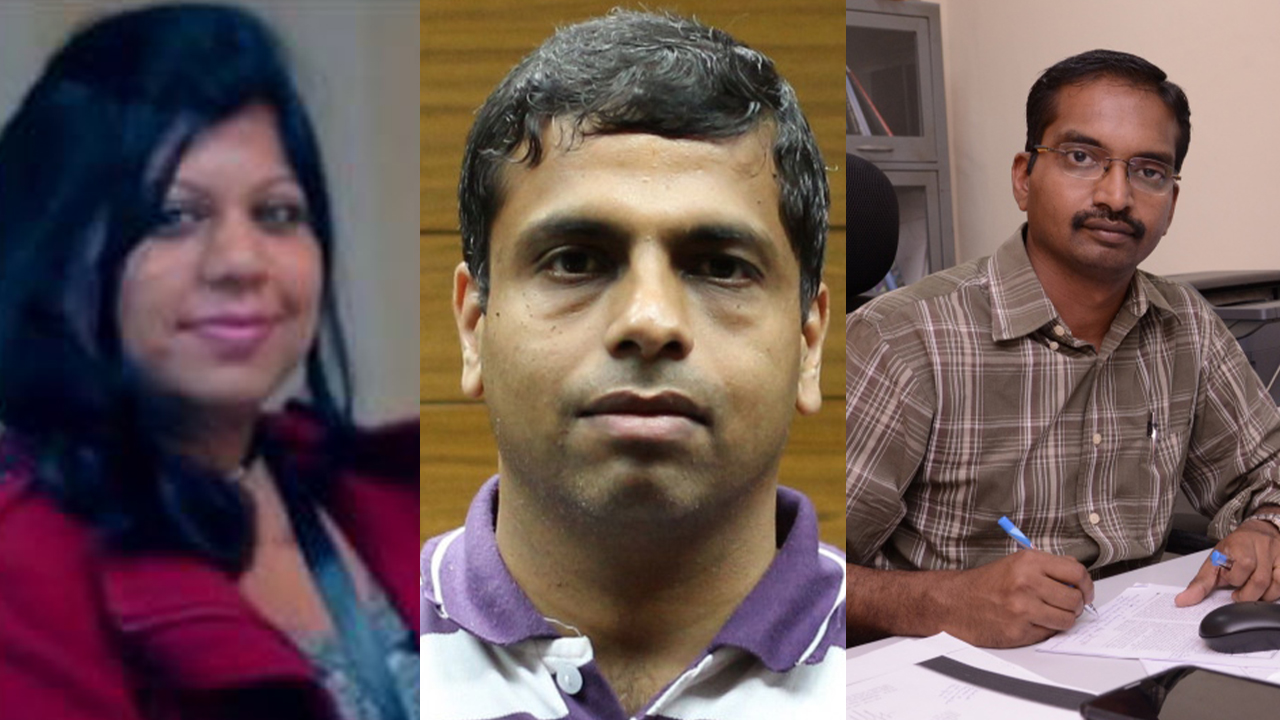
The Department of Physics organised a Faculty Development Programme discussing the scopes of implementing sponsored projects. Renowned academicians, Prof Sathish Vadhiyar, IISc Bangalore; Prof Kothandaraman Ramanujam, IIT Madras; and Prof Paromita Chakraborty, SRMIST were the keynote speakers of the session. They shared their views and enlightened the faculty on the scopes and challenges in implementing projects proposed across various disciplines.
Prof V S Rao, Vice-Chancellor SRM-AP, welcomed the gathering. He appreciated the department’s effort in organising programmes on such impactful topics. Reminding the community of the inevitability of emphasising research, he congratulated all the faculty for their influential publications, sponsored projects, patent publications, etc. Prof D Narayana Rao, Pro-Vice-Chancellor, also addressed the gathering and reiterated the need to conduct such crucial discussions among administrators and policymakers. He further highlighted the importance of reorienting the vision of every Indian university by giving a special focus on research and development.
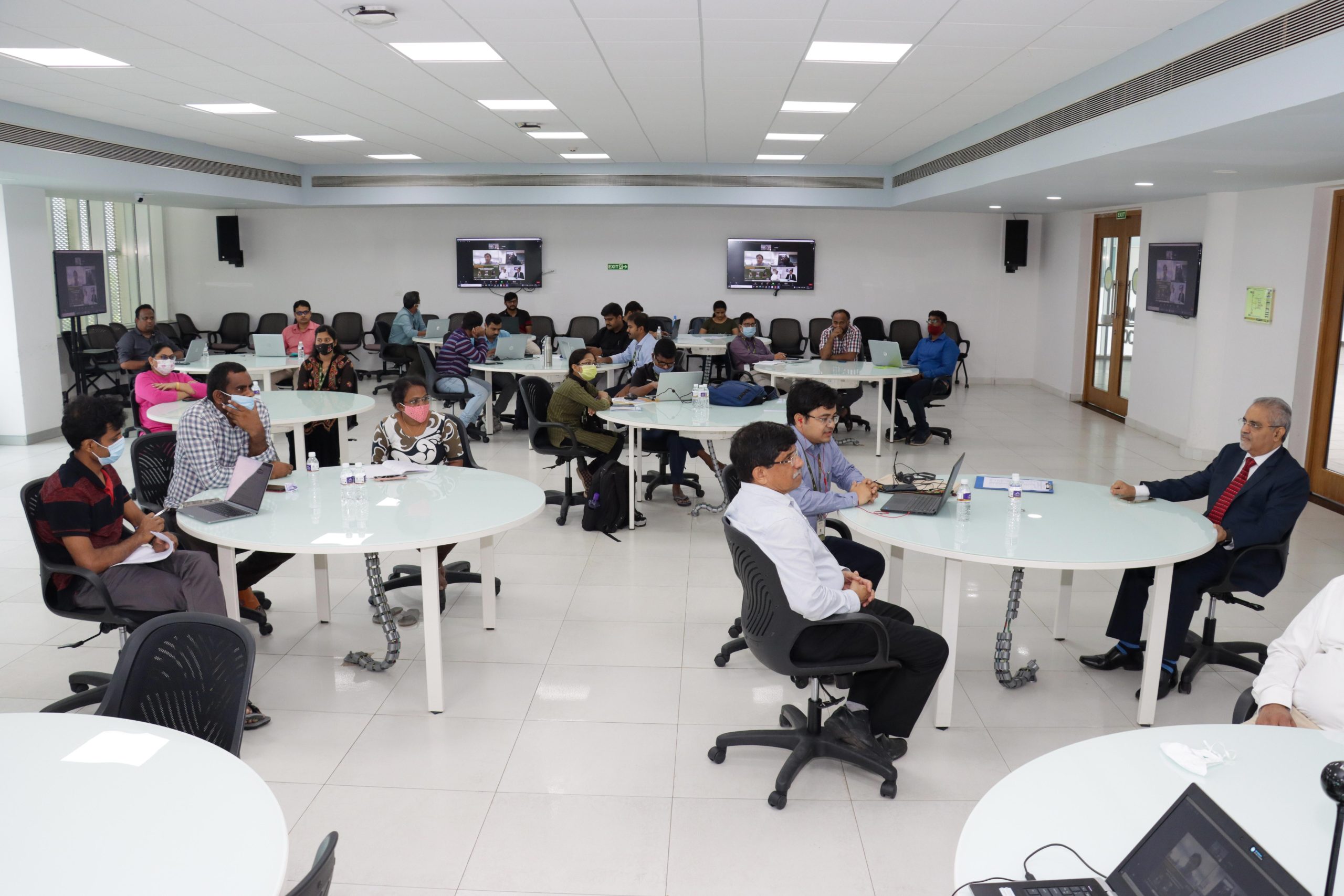
Prof Sathish Vadhiyar commenced the discussion by providing a brief overview of the National Super Computing Mission (NSM). It is one of the principal ventures funded by DST and MeItY to advance the overall high-performance computing ecosystem. He deliberated on the R&D projects involved in NSM, its objectives, proposal areas, budget, research allocations etc. Prof Ramanujam presided over and shared his experience in collaborating with industries to market the research product. He gave a detailed analysis of the functioning of consultation companies, types of consultancies, stages involved in such projects, and the different ways to attract funding. Prof Paromita Chakraborty was the last speaker of the day. She offered an elaborate outline for designing and developing a project proposal and concluded by imparting a few insights from her successful projects.
Continue reading → - One-stop solution to green urea synthesis May 12, 2022

Prof Ranjit Thapa and his PhD scholar, Mr Samadhan Kapse from the Department of Physics have reported their euphoric achievement of discovering an economically viable electrocatalyst for effective green urea synthesis. The paper “Selective Electrocatalytic Co-reduction of N2 and CO2 on Copper Phthalocyanine for Green Urea Production” has been published in the highly prestigious Nature indexed journal, ‘Advanced Functional Materials’, having an Impact Factor of 18.81. It was published in collaboration with Jit Mukherjee, and Uttam Kumar Ghorai, from the Department of Industrial Chemistry & Applied Chemistry, Swami Vivekananda Research Centre.
With global annual production of 100 million tons, urea is one of the important nitrogen sources for the fertilizer industry. Industrial urea is synthesized by the following two consecutive steps. First, the reaction of nitrogen and hydrogen (N2 + H2 → NH3) by the Haber-Bosch process at high temperature and pressure (350–550°C, 150–350 bar); followed by the reaction of NH3 and CO2 [NH3 + CO2 → CO(NH2)2] under mild reaction conditions (170–200°C and 200–250 bar). The sequential reactions are carried out for several cycles to increase the conversion efficiency. For the first step, fixation of N2 is an energy as well as a capital intensive process due to difficulty in cleaving the N≡N bond. Extensive research works have been reported on electrochemical N2 fixation to NH3 in water medium under ambient conditions. In this electrochemical method, isolation of NH3 gas with high purity from electrolyte solution is troublesome. In the second step, CO2 fixation on the substrate and its separation is one of the major challenging tasks for the further reaction with NH3 to end up in urea formation. Overall, the two-step process for large scale production of urea consumes high energy and produces greenhouse gases for the environment.
The research team reported copper-phthalocyanine nanotubes (CuPc NTs) having multiple active sites as an efficient electrocatalyst which exhibits a tremendous yield of urea with good durability and long-term stability. DFT calculation predicts that Pyridinic–N1 in CuPc is responsible for N2 reduction and the metal centre plays an important role for CO2 reduction. This study not only provides us with the co-reduction of N2 and CO2 gases using cost-effective CuPc NTs catalyst but also opens a new pathway to the rational design of other transitional metal-based electrocatalysts having multiple active sites for N2 and CO2 gas fixation applications.
This electrochemical method of urea synthesis by the co-reduction of N2 and CO2 [N2 + CO2 + 6H+ + 6e– → CO(NH2)2 + H2O] using an efficient electrocatalyst in a water medium under ambient conditions would be an alternative way in the upcoming days. All the strategies using alloys and heterostructure for urea synthesis forming C–N bond by the co–reduction of N2 and CO2 have not reached the benchmark in terms of urea yield rate and FE for practical applications. To achieve a high urea yield and FE, various factors are to be considered in this work.
Abstract of the Research
Green synthesis of urea under ambient conditions by electrochemical co-reduction of N2 and CO2 gases using effective electrocatalyst essentially pushes the conventional two steps (N2 + H2 = NH3 & NH3 + CO2 = CO (NH2)2) industrial process at high temperature and high pressure, to the brink. The single-step electrochemical green urea synthesis process has hit a roadblock due to the lack of an efficient and economically viable electrocatalyst with multiple active sites for dual reduction of N2 and CO2 gas molecules to urea. Herein, the research reports copper-phthalocyanine nanotubes (CuPc NTs) having multiple active sites (such as metal centre, Pyrrolic-N3, Pyrrolic-N2, and Pyridinic-N1) as an efficient electrocatalyst which exhibits urea yield of 143.47 µg h-1 mg-1cat and FE of 12.99% at –0.6 V vs RHE by co-reduction of N2 and CO2. Theoretical calculation suggests that Pyridinic-N1 and Cu centres are responsible to form C–N bonds for urea by co-reduction of N2 to NN* and CO2 to *CO respectively. This study provides new mechanistic insight into the successful electro-reduction of dual gases (N2 and CO2) in a single molecule as well as the rational design of an efficient noble metal-free electrocatalyst for the synthesis of green urea.
Continue reading →

